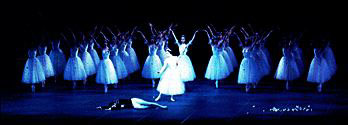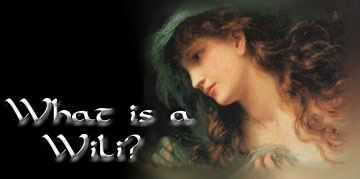

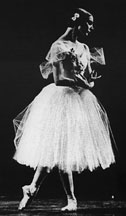
Well, if you've heard of them at all, chances are it was from the ballet Giselle, and the Wilis you've seen look a lot like this photo of Antoinette Sibley of The Royal Ballet. The ballet has been a favorite of mine since I was a little girl in pink leotards--not so much because it's a tragic love story, which is the main reason it has remained popular for over 150 years, but because it's a ghost story. It was originally presented by the Paris Opera Ballet in 1841, choreographed by Jean Coralli and Jules Perrot to a score by Adolphe Adam and story by Theophile Gautier and Vernoy de Saint-Georges. Giselle is a high-spirited but somewhat fragile peasant girl whose sweetheart, "Loys", is really the nobleman Albrecht in disguise--and he's already betrothed to the princess Bathilde! Sooner or later, of course, these things have to come out; and in this case the result is Giselle's famous "mad scene" at the end of Act I. In some versions her heart gives out from the strain, in others she snatches up Albrecht's sword and kills herself. Either way, she has died deceived by the man she loves, and is condemned join the spirits of other maidens who have suffered that fate--the Wilis--haunting the forest from midnight to dawn each night, and forcing any man who wanders into their path to dance until he expires from exhaustion. We first see this happen to Hilarion, the huntsman who also loves Giselle and exposed Albrecht's deception. Then Giselle is called from her grave by Myrtha, the Queen of the Wilis, and ordered into action when Albrecht comes along. Defying the Queen, Giselle protects her beloved from the others, breaking the curse and earning the right to remain at peace in her grave when she returns there at dawn.
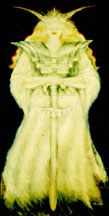
Now, resting in peace is all well and good, but truth be told I always thought the Wilis--beautiful, cold, and quite deadly--were a lot more interesting. Giselle is high-spirited and sweet and noble; Myrtha is a woman not to mess with. (Plus she's usually portrayed by the tallest woman in the company, so if I'd pursued ballet as a career--which I considered for quite a while as a kid--I'd probably be finding my 5'9" self in her shoes a fair amount!) Gautier and de Saint-Georges based their story on myths of the Wilis as vengeful spirits or faeries waiting to lure the unwary to a watery doom, but the tales are age-old and may have lost a little something over the centuries. According to Barbara G. Walker in The Women's Encyclopedia of Myths and Secrets, a Wili or Vila is a "Slavic witch-spirit associated with water; cognate of the Scandinavian Vala or Valkyrie." (right)
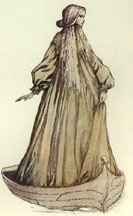
Ms. Walker also notes that "Sometimes, especially favored men were invited to join the Vilas for a while, usually seven years. A man would be invited into a cave or hollow tree, and find himself in fairyland." Another water-faerie said to go in for that kind of thing is the Welsh Gwragedd Annwn. (left) One legend tells of the Gwragedd Annwn inviting mortal men into their garden for as long as they like on the condition that nothing be taken from it. When one disobeys and smuggles out a flower, he falls into a coma and the faeries' garden is closed to the visitors forever. A bit less vindictive than catching guys and dancing them to death; but still a reminder that when faeries set down rules, you better follow them!
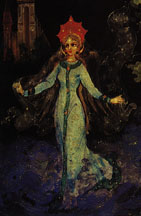
And just in case I need a few more sisters: "Russian Vilas were sometimes known as Rusalki [singular, Rusalka (right)], daughters of Holy Mother Russia (Earth). Like Valkyries, the Vilas of old had charge of the rites of death and the guiding of souls... Vilas or Wilis came to be feared as angry, dangerous 'souls of drowned women' who dwelt in water, perhaps because so many 'witches' were drowned. Like Sirens, they were supposed to draw into the waters any heedless wayfarer who happened to see them dance by moonlight... [T]he old fear of them resides in such phrases as 'it gives me the willies.' A cold shudder was said to be a prophetic touch from a Wili's deathly hand. However, traces of the priestesses' former benevolence are found in the legend that where they danced on the nights of the old pagan festivals, there the grass grew thicker and the wheat flourished more abundantly."
Top graphic adapted from Head of a Nymph by Sophie Anderson; special thanks to ArtMagick. Excerpts from The Women's Encyclopedia of Myths and Secrets © 1983 by Barbara Walker, published in 1996 by Castle Books, a division of Book Sales, Inc. Antoinette Sibley photo by Leslie E. Spatt. "The Valkyrie" by John Gruse is from Olaf Svava's Valkyrie page. Gwragedd Annwn illustration by Brian Froud, from Faeries, © 1978 Rufus Publications, Inc. Rusalka illustration from Russian Lacquer, Legends and Fairy Tales by Lucy Maxym, © Siamese Imports Co. Inc. Below: the Asami Maki Ballet production of Giselle, photo by Masaki Hataya.
